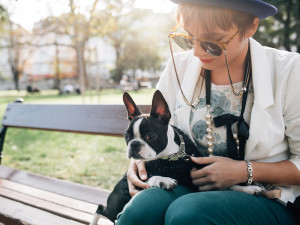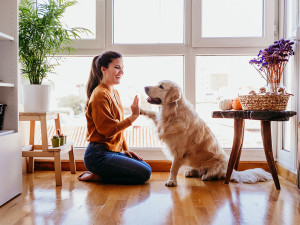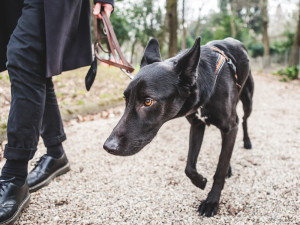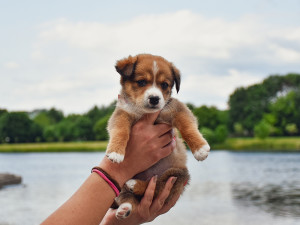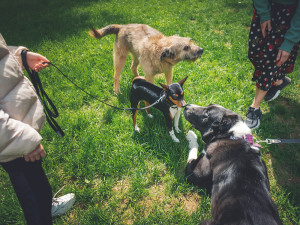How To Help Your Dog Deal With A Toddler In The Wild
Unsolicited approaches from children can’t always be predicted
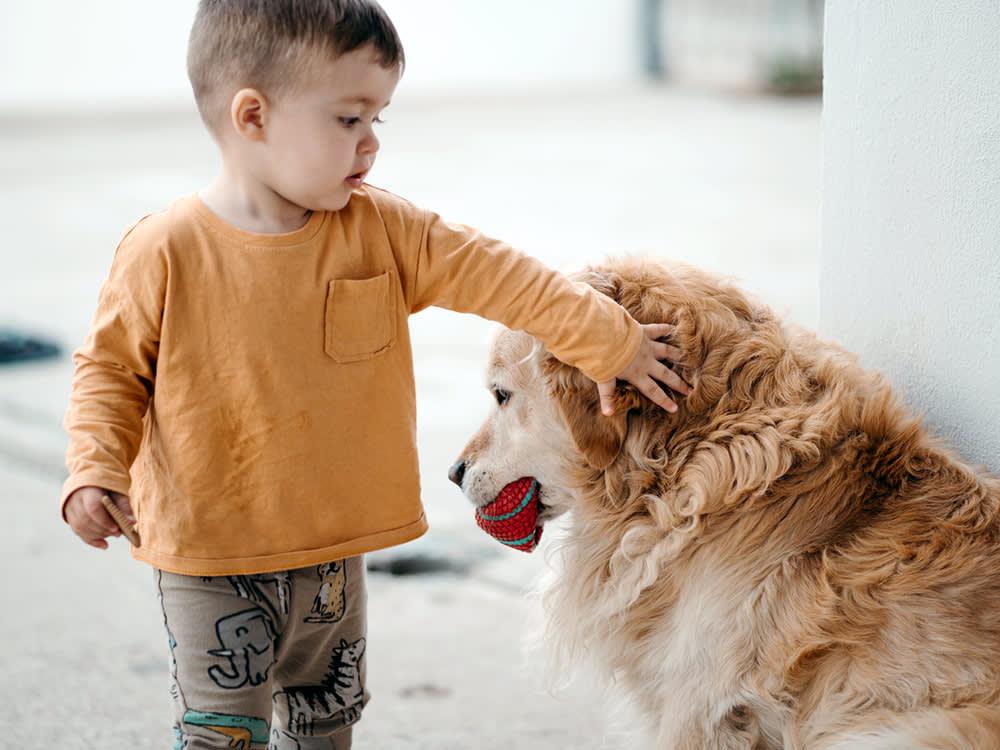
share article
We all know that dogs are cute; who wouldn't want to go and say hello to a particularly adorable pup in the park? The dog, however, might not be so keen on a stranger coming towards them, arms outstretched.
Thankfully, most adults can either read the dog to know whether approaching is a good idea or they have the ability and wherewithal to ask the pet parent’s permission beforehand. This gives the pet parent time to make the best decision for everyone.
Kids, on the other hand, don’t develop self-control until around the age of seven and can be prone to running up to the nearest dog with arms wide open, expecting a warm welcome.
But it doesn’t always go that way. Unfortunately, the number of dog bitesopens in a new tab reported in the UK was at an all-time high in 2022–23, with bites to children accounting for around 20% of these. This isn’t said to scare you. It’s more to underline the importance of preparing your dog for any interaction with children that ensures the safety of both them and the child.
Why do dogs and children not always get on?
Dogs naturally find children more challenging than adults despite our rose-tinted view of how they should get on (thank you heartwarming 90s family movies). This is due to the inherent unpredictability, higher levels of noise and erratic movements associated with kids.
So, although it is alarming and sometimes upsetting, it should come as no surprise when an interaction between a dog and a child doesn’t go as planned. Even minor scuffles or nips are likely to be much more serious when a child is involved due to their thinner skin and the fact that their faceopens in a new tab is likely to be in closer proximity to the dog’s teeth.
As a pet parent, the safeguarding of both your dog and any children that they interact with is critical. If done well, the interactions between dogs and children can enrich the lives of everyone involved but it takes work, management and close supervision. It can be frustrating when children approach your pet without warning, but the unfortunate reality is you can’t always control the external factors your pup is going to experience, especially if you live in a busy area.
Teaching your dog to be comfortable around children
The most important way to ensure that everyone is safe and protected if a child does come up to your dog out of nowhere is to listen to your dog. If they are uncomfortableopens in a new tab then things can go south very quickly. Dogs bite due to fearopens in a new tab and frustration, both of which can be felt in response to an interaction with a child. But dogs can also injure children due to positive reactions; a large boisterous Labrador can easily knock a child over by accident, or a little terrier could scratch them whilst jumping up. Teaching our dogs to cope well around childrenopens in a new tab they may encounter is vital as well as learning to manage any interactions around children in the moment actively.
Socialisation is a term you’ve likely heard of and it’s a crucial aspect of training aimed at teaching our dogs to be sociableopens in a new tab with people, including children. However, socialisation is often misunderstood. It is not about exposing your dog to lots of children in the hope that they learn to be OK around them. In fact, less is often more. The key requirement in socialisation is how your dog feels. If your dog feels uncomfortable in any way throughout the process then they are not being socialised, they are instead being sensitised and learning to like children less the next time they see them.
Instead, we want to build a positive association with children, this is relevant whether you have a little puppy or an older dog. All dogs learn the same way. Puppies up to the age of 12 weeks are in their socialisation period, which means they are especially susceptible to this learning – whether positive or negative. This age can set your dog up to be more or less likely to cope with interactions in the future. But other things also affect learning in this period, especially a dog's genetics and their experiences with the breeder, so it’s important to remember that puppies are not always the blank slate people often think they are.
With older dogs who have had limited or negative experiences, or rescue dogs where you are unsure of their history, you might need to take things a lot slower and it may take them longer to progress. But as long as you listen to your dog they will continue to improve at their own pace.
It is important for your dog to be spending time around children at a distance that your dog feels completely comfortable with (even if that’s 50 or 100 meters or more away), whilst your dog experiences things they enjoy. Think treats, play or access to sniffing. Combining something your dog is unsure of (such as children) with something they like is a great way to improve their perception of it.
If your dog is enjoying their interaction with children at a distance, this can progress to direct interactions with children. Pet parents must monitor for any signs your dog needs a break. These signs can be obvious, like your dog physically moving away from the child, or your dog telling the child to move away with signs such as a growl, snarl or a snapopens in a new tab but they can also be much more subtle. Changing to negative body language is an early warning sign. Watch for their tail dropping lower and ears turning backwardsopens in a new tab. Licking their lips or yawning are other stress signals that can indicate it’s time to put an end to the greeting.
Managing your dog’s interactions with children
As well as preparing your dog in advance for interactions with children, the responsibility you have as a pet parent is learning to manage interaction in the moment. You are your dog’s advocate and must protect them from any interactions in which they are not completely comfortable for both their safety and the safety of any children that they interact with.
It is important to have plans in place for a number of situations. In the case of a child that is keen to interact with your dog where you feel confident your dog will be OK with it, follow these steps:
Aim to get the parent and child on board.
Ask the child to stop at a distance where your dog can’t make contact with them. If a child is under a certain age, this may involve getting the parents to physically stop them.
Try to keep your dog’s lead loose rather than adding tension to the situation.
Give the child something positive to do with your dog, rather than leaving it up to them to decide. I like asking them to throw treats for my dog to collect (much safer than taking treats from hand). I might ask them questions about my dog such as “What colour is his collar?” or “Can you see his wagging tail?” Or I suggest they ask my dog to do a simple trick that he knows.
If your dog is comfortable then a quick stroke on their side, not over their head, is most likely to be tolerated whilst you keep the head end busy working for more treats.
Short, sweet interactions have the best chance of success and continue to set your dog up to expect good things around children in future.
Your dog might not want to interact with any children, they may be ill or injured, or just too tired to interact. Or maybe the child isn’t able to follow your instructions for a safe interaction. In these cases, having a back-up tactic to get you out of there easily and to keep the situation stress-free for everyone is vital.
Use your body to get between the child and your dog.
State that your dog needs space. A simple “He’s in training”, “She’s scared of people” or “He’s too tired, sorry” is all that’s needed.
Move your dog away without entering further conversation, you don’t want this to become a debate or argument with a child and dog around so a sharp exit is the least confrontational option.
If a child has already run in and started an interaction with your dog before you’ve had a chance to intervene then you also need an emergency response in your back pocket. If you can, get treats to your dog to encourage them to move away in a calm, swift manner then retreat to a distance that they feel comfortable. You can then open a dialogue with the child and their adult about what your dog may or may not feel comfortable with and start afresh.
What else can I do to avoid stressful interactions with children?
You can make it less likely that your dog is bothered by people at times when they need space by using labelled jackets or leads asking for space. Unfortunately, sometimes these can inadvertently draw attention to your dog so use them with caution.
The most effective gear you can add to a situation is a muzzle. Not only does this make your dog safe but it actively encourages people to stay further away, which is sometimes exactly what you might need. It can feel like an extreme step but no one who has ever needed a muzzle has regretted having it. These days they come in fun colours and dogs can really enjoy wearing them as long as they are basket-type muzzles such as those from The Muzzle Movementopens in a new tab. Teaching your pup how to wear them in a positive way is key.
Hopefully, you’ll feel more prepared wherever your dog is around interactions with kids now, and have more confidence facing children out and about moving forwards. It can feel like a lot of pressure to let children interact with your dog, but if your dog isn’t enjoying it then we are teaching the child to ignore dogs’ warning signals which puts them at risk of bites in the future. Protecting your dog in every interaction goes a long way to educate children and their adults which helps to protect them and other dogs they interact with down the line.

Dr Katie Friel-Russell, BVSc, MAPDT, PGDip, CCAB, MRCVS
Dr Katie Friel-Russell is a Veterinary Behaviourist and Head Trainer at Positive Pet Trainingopens in a new tab based in Staffordshire. She graduated from the University of Liverpool School of Veterinary Science in 2012 and worked in a small and animal hospital for two years before beginning work treating animals with behavioural concerns, completing a postgraduate diploma in animal behaviour at Lincoln University and becoming a certified clinical animal behaviourist. She now works full-time running Positive Pet Training’s Veterinary Behaviour Clinic.
She also enjoys preventative training including working with puppies, gun-dog training and scent work. As well as offering online, self-paced courses covering all behaviour, ages and types of training on the Positive Pet Training Portal.
Outside of work, Dr Katie loves playing and training with her little miniature pinscher dog Cornelius, her cat Thomas and three pet rats.
Related articles
![A woman holding a dogs paw and smiling.]() opens in a new tab
opens in a new tabNine Useful Tricks to Teach Your Dog
Go beyond the basics
![Stylish woman sitting on a bench with her Boston Terrier dog.]() opens in a new tab
opens in a new tabHere’s Why Your Dog Is Terrified of New People
And how to change it
![Two hands holding a very young tan and white puppy up in front of a lake landscape]()
How to Socialise a Puppy
Everything you need to know to get your new addition off to a good start
![Three dogs on leashes meeting and sniffing each other on a walk on the summer grass with owners]()
How Do I Get My Shy Dog To Socialise?
Dog trainer Robert Haussmann’s tips for getting a shy pup to go from wallflower to social butterfly
![pet lover concept with mini dog on woman leg. sitting in room at home]() opens in a new tab
opens in a new tabWhat’s the Deal, Mouthy Puppies? Why Bite Inhibition Matters
How to teach your pup to play nice
![A senior Retriever/Terrier mixed breed dog shaking hands with its owner.]() opens in a new tab
opens in a new tabHow to Teach an Old Dog New Tricks
Your senior dog might move slower these days, but that doesn’t mean they can’t learn new things
